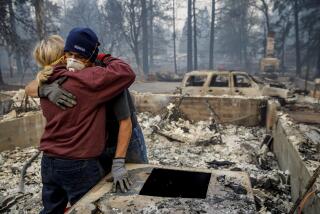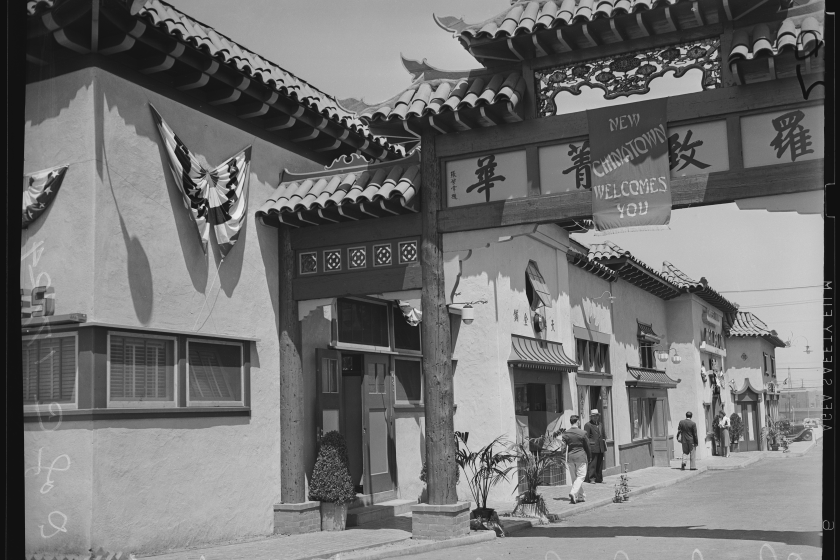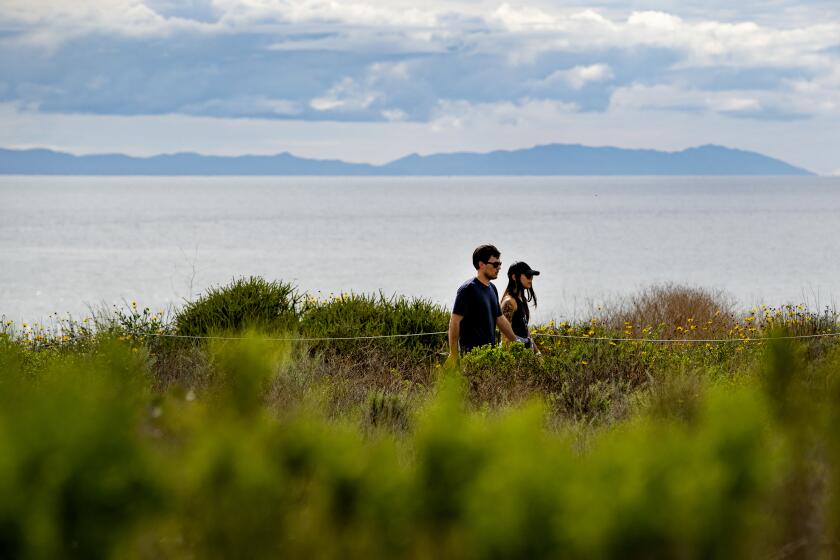Op-Ed: California is uniquely fire-prone thanks to its long romance with high-voltage power lines

The recent fires in California have been rightly linked to global warming. But as more residents are learning every year, another long-term factor is playing a key role: California’s power grid.
Cal Fire estimates that electric power networks have caused about 10% of California’s recent wildfires, including some of the most devastating. Although the role of power lines in the Camp and Woolsey fires is not yet confirmed, Southern California Edison has admitted its lines helped ignite the devastating Thomas fire a year ago, and PG&E, whose power lines have been implicated in a number of major fires, is set to file for bankruptcy protection.
California has an especially combustible combination of high-voltage electricity and highly flammable landscapes. This volatile situation is the result of a long infatuation with electricity that began more than a century ago.
California in its early days lacked easy access to coal, and by the late 19th century, it was rapidly running out of cheap timber. What it did have was water, in the swift-flowing rivers and streams of the Sierra Nevada.
California’s demand for electricity continues to grow, currently at an average of about 10% per decade.
California thus turned early to hydropower, encouraged by Gold Rush-era innovations in hydraulic mining that moved water across mountainsides. Early in the last century, the whirling turbines of Big Creek and other hydropower complexes in the Sierras began sending abundant, cheap power to Southern California, and Big Creek today still feeds a billion watts into the Edison grid.
There was one problem: These sources of hydropower in the rugged Sierras were hundreds of miles from the cities where most Californians lived. So a vast web of electricity transmission lines was draped across the landscape, many of them at high voltages to minimize power losses.
By the 1910s, California had more high-tension lines than anywhere else in the world. With the construction of Hoover Dam, California’s electrical infrastructure extended even to neighboring states. All those high-voltage power lines crossed a precarious landscape, often along chaparral-covered foothills where a spark from an arcing power line could ignite an inferno.
To help build this network, California’s scientists and engineers mastered the art of high-voltage transmission. A century ago, UC Berkeley, Stanford and what would become Caltech built world-class programs in electrical engineering. They concentrated on developing insulators, transformers, switches and lines that could operate at high voltages with few losses. (Those same electrical engineering programs would help nourish high-tech industries, from aerospace to Silicon Valley.)
Californians have been happy to use the abundant electricity, regardless of where it came from. By 1930, the state was consuming electricity at more than twice the national rate. Consumer demand continued to grow insatiably, driven first by electrical appliances and TVs in the mid-20th century and more recently by computers, smartphones, electric cars and server farms.
Maintaining high-voltage lines in the natural environment was not as simple as in the lab, however. Trees grow, winds blow, and sparks fly to dry tinder.
California’s long romance with high-voltage transmission has meanwhile become a liability owing to aging infrastructure. The investigation of the Camp fire is focusing on a transmission tower along PG&E’s Caribou-Palermo line, which operates at 115 kilovolts. That line was built in 1919 to carry electricity from a series of hydropower stations on the North Fork of the Feather River, a cascading Sierra watershed so bountiful in its generating potential that it was known as the “Stairway of Power.” Some of those transmission towers are now a century old, their metal components in danger of failing.
Enter the Fray: First takes on the news of the minute »
Yet California’s demand for electricity continues to grow, currently at an average of about 10% per decade. That rate that is projected to continue through 2030. (One surprising new drain on the grid is legalized marijuana. Lights and ventilation for indoor pot farms are estimated to increase total electricity demand in California by 2%.)
As California adapts to climate change, its embrace of alternative energy will further disperse electricity generation. Wind and solar farms require vast open spaces. The Alta wind farm near Tehachapi Pass covers several thousand acres, as does the Topaz solar farm on the Carrizo Plain. Like the hydropower plants before them, these farms are located far from the people who use the electricity they produce, which means ever more high-voltage lines across the land.
Technical experts and policymakers will consider ways to reduce the risks posed by all these power lines: better insulation, brush-clearing, and plans for shutting them down in hazardous conditions. Running the lines underground is another option, albeit an expensive one: There are hundreds of thousands of miles of power lines in California, and it can cost a million dollars per mile to bury a line.
Meanwhile, the lines themselves, and the volatile landscapes they traverse, will remain, as will our infatuation with electricity. When we flick on the lights or plug in our devices, many of us don’t think about where the electricity comes from. Increasingly, fires will remind us that all that electricity comes with a cost.
Peter Westwick is adjunct research professor of history at USC, where he teaches the history of science and technology in California.
Follow the Opinion section on Twitter @latimesopinion or Facebook
More to Read
A cure for the common opinion
Get thought-provoking perspectives with our weekly newsletter.
You may occasionally receive promotional content from the Los Angeles Times.






